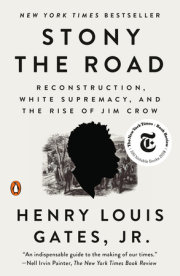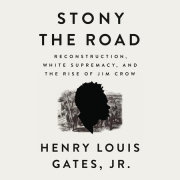One
Antislavery/Antislave
The only place the American historian could find for the colored man was in the background of a cotton-field, or the foreground of a canebrake or a rice swamp, to adorn the pages of geography, and teach the rising generations of civilized and Christianized America the true position of the generous Negro. . . . But a change has come over the spirit of their dreams. . . . [O]ld things are passing away, and eventually old prejudices must follow. The revolution has begun, and time alone must decide where it is to end.
-C. P. S., "The Crisis," Pacific Appeal 24, September 13, 1862
I actually think the great evil of American slavery wasn't involuntary servitude and forced labor. The true evil of American slavery was the narrative we created to justify it. They made up this ideology of white supremacy that cannot be reconciled with our Constitution, that cannot be reconciled with a commitment to fair and just treatment of all people. They made it up so they could feel comfortable while enslaving other people. . . . [S]lavery didn't end in 1865; it just evolved. . . . The North won the Civil War, but the South won the narrative war.
-Bryan Stevenson, Vox magazine interview, May 2017
The hope engendered by the triumphant election of Barack Obama as the first black president of the United States called to mind other exhilarating historical moments for African Americans, especially during the Civil War and Reconstruction, including the signing of the Emancipation Proclamation on January 1, 1863, the ratification of the Thirteenth Amendment on December 6, 1865 (which legally abolished slavery), and the passage of the Reconstruction Acts, which inspired a collective sense of optimism among formerly enslaved African Americans, "a millennial sense of living at the dawn of a new era," in the words of Eric Foner. At the dawn of a new era in the next millennium, President Obama's election, unthinkable even a decade before and unprecedented in its potential implications for ameliorating race relations, led some commentators to speculate about an "end of race and racism" narrative. Among the many writers who embraced this optimistic idea was the novelist and philosopher Charles R. Johnson, who argued even in the summer before Obama was elected, "It is no longer the case that the essence of black American life is racial victimization and disenfranchisement, a curse and a condemnation, a destiny based on color in which the meaning of one's life is thinghood, created even before one is born." Regardless of the outcome, Johnson argued, the brilliance and poise that Obama displayed during his campaign alone would spur the country to "transcend parochialism, tribalism, and that most pernicious of fictions-race." Obama had written far more cautiously in The Audacity of Hope two years before his election that "such prejudices" were "subject to refutation." Johnson may have been one of the first writers to embrace this idea, but he was far from alone. Claims about the dawn of "a post-racial America" led the Harvard sociologist Lawrence D. Bobo to reflect upon the several different manifestations of this phenomenon in a searching critique published in 2011. Looking back roughly two years after Donald J. Trump's election, the idea that one black person's occupancy of the White House-and a presidency as successful as his-could have augured the end of race and racism seems both na•ve and ahistorical.
Obama's election, to my enormous surprise, revived an old metaphor with a long and curious history in African American letters, that of a New Negro, a "new" kind of black person. For example, Johnson aptly characterized the Obamas' many strengths in this way: "Eloquent and elegant, charismatic and holding [degrees] from Harvard Law, always comfortable in [their] skin, [Barack] and Michelle are also avatars of a new black America." The professor and political historian Ronald Williams made the link between Obama and the metaphor of the New Negro explicit in a perceptive essay titled "The New Negro in African American Politics." Invoking the metaphor of the New Negro to account for the extraordinary feat that Barack Obama achieved unwittingly connected the Obama presidency to the optimism and expectations-and severe disappointments-of the rise and fall of Reconstruction, in the aftermath of which the metaphor itself was first coined as a complex defensive mechanism that black people employed to fight back against racial segregation. This book is about that optimism and those expectations, the painful manner in which they crumbled, and the creative manner in which African Americans sought to counter Jim Crow segregation as it systematically rolled back the dramatic, once unimaginable gains that they had achieved in the decade or so following the end of the Civil War.
We might think of the New Negro as Black America's first superhero. It was, as we shall see, the shrewd and canny, if complicated, black response to the claim of the birth of a "New South," a phrase coined by the charismatic white supremacist journalist Henry Grady as early as 1874, but then popularized in a widely commented-upon speech he delivered to a New York audience twelve years later in 1886. The declaration of the existence of a New South only a decade after the end of Reconstruction was warmly embraced by key interests in the North and signaled the triumph of the South's "Redemption." Grady's metaphor was intended to demonstrate to the North, in seductive, easily digestible language that the South-though it had nothing for which to apologize, and most certainly not the institution of slavery-had reinvented itself following the war and had now achieved "the perfect democracy," precisely as it was aggressively dismantling the advances in rights that black people had enjoyed during Reconstruction. That's how Grady packaged it anyway. Redemption, as the civil rights attorney Bryan Stevenson points out, essentially imposed a system of neo-enslavement on the South's agricultural workers, who were the recently freed African Americans and their children.
Grady's clever declaration of the birth of a New South unfolded as part of what we might say amounted to a terrorist campaign against the freedmen and freedwomen, waged not only through physical violence and intimidation, but also through a massive wave of propaganda hell-bent on permanently devaluing the freedpeople's very humanity-often referred to in scientific literature of this period as "the nature of the Negro"-on defining who, and what, a black person actually "was," within or, alarmingly, outside of the human community. This propaganda war was so brutally effective that it demanded a response from black people themselves in all available media. One such response was the declaration of the advent of a so-called New Negro, a postwar phenomenon that stood as evidence that the disparaging claims about the Negro's beastlike "nature" were horribly mistaken. So powerful was the trope of the New Negro that one is tempted to say that it has turned out to be, ironically, one of the most lasting legacies of the long Reconstruction era. Indeed, the philosopher and critic Alain Locke, who appropriated the term in 1925 for his own purposes at the apex of the Harlem Renaissance, would later argue that every generation of African Americans needed to renew itself through successive "New Negro Movements."
Why the reconstitution of a supposedly New Negro? It became a necessity, it was argued, because the image of the Old Negro had been so devastatingly deconstructed by the "redeemed" South in the rollback of Reconstruction. This process calls to mind the alt-right-fueled rollback of policies pivotal to President Obama's legacy under the counterrevolution being led by his successor, President Donald J. Trump. Who could have predicted that the election of the first black president would become a focal point for triggering a dramatic rise in the public expression of some of the oldest, nastiest, and most vulgar white supremacist animus about black people? That reactionary rancor extended a tradition that had begun with the defense of slavery long before the Civil War and continued throughout it-indeed, the 1864 presidential election was full of fearmongering over the supposed racial "amalgamation" that would follow if Lincoln won another term-taking on new and equally energetic forms of venality well into the twentieth century. This desperate effort to reassert white supremacy and decimate the gains in black equality promised by Reconstruction led to the effective disenfranchisement of black male voters in the former Confederate states and the imposition of "separate but equal" as the law of the land. While white supremacist ideologies never disappeared, I think that many of us, viewing Obama's election as the culmination of the successes of the civil rights movement, had convinced ourselves that the more excessive forms of white supremacy had gone deep underground, or at least lay dormant. But because these beliefs continue to manifest themselves so very openly today in the wake of the end of the two terms of the first black president, it is useful to retrace their history as well as the manner in which black people and their allies so nobly fought back against them through a variety of strategies ranging from political action to symbolic gestures at the level of representation, such as the invention of the concept of a New Negro. In that sense, when hopeful commentators hailed the election of the first black president by employing this metaphor, they unintentionally reconnected Black America, full circle, to an earlier period when the fight against white supremacy was literally a life-and-death struggle.
A Look at Reconstruction
The eruption of the expression of white supremacist ideology in what increasingly appears to be a determined attempt to roll back the very phenomenon of a black presidency is just one reason that the rise and fall of Reconstruction and the surge of white supremacy in the former Confederate states following the end of the Civil War are especially relevant subjects for Americans to reflect upon at this moment in the history of our democracy. In fact, I'd venture that few American historical periods are more relevant to understanding our contemporary racial politics than Reconstruction. Think of the fundamental questions that the study of the period forces us to consider: Who is entitled to citizenship? Who should have the right to vote? What is the government's responsibility in dealing with terrorism? What is the relationship between political and economic democracy? These are all Reconstruction questions. Reconstruction-when the country intended to institutionalize for its black citizens what President Lincoln had called "a new birth of freedom"-saw the passage of the country's first civil rights laws and the amending of the Constitution, forming the basis of the rights revolution of the modern era that continues to this day, most recently in the ruling that established the right to marry without discrimination based on gender or sexual preference.
One of the most shocking things to realize about Reconstruction is how painfully short it was, compared to the dreadfully long duration of slavery. Though scholars differ on when Reconstruction began-whether in 1861 or 1863 or 1865-it was clearly on the road to ending by the Panic of 1873, the first "Great Depression" in post-Civil War America, and suffered a devastating political blow just four years later, with the Compromise of 1877, which, in the most stripped down of terms, secured the election of Republican Rutherford B. Hayes by giving him the electoral votes of Democratic South Carolina and Louisiana in exchange for a promise to withdraw the remaining federal troops from those statehouses. Regardless of its brevity, Reconstruction remains one of the most pivotal eras in the history of race relations in American history-and probably the most misunderstood.
When the Civil War began in 1861, Reconstruction was really a process question: If and when the Union was saved, how would the eleven states that had seceded to form the Confederacy be reabsorbed? On that the US Constitution was silent. Improvisation would prove unavoidable.
As the rebellion dragged on and the war hardened, the definition of Reconstruction changed. There could be no "reconstructing" the Union as it had been. With the aim of the struggle eventually expanding from saving the Union alone to saving it by emancipating the Confederacy's slaves (and with the arming of those brave black men among them willing to fight and die for the cause), Reconstruction took on a double meaning: both of readmitting the conquered Confederate states to the Union and of granting freedom, citizenship, and a bundle of political, civil, and economic rights to African Americans-both those free before the war and those freed by it. Reconstruction, in this sense, meant repairing what the war had broken apart while simultaneously attempting to uproot the old slave system and the ideology underpinning it that had rationalized the process of making property of men a "black and white" issue. As the historian David Blight says, Reconstruction at once called for both "healing" and "justice," and those competing ends would not only remain in tension throughout the period; they would also prolong an enormous amount of racial violence until Reconstruction itself was overthrown.
The process of Reconstruction involved nothing less than the monumental effort to create a biracial democracy out of the wreckage of the rebellion. Though that effort ultimately was thwarted, Reconstruction saw the passage of a vast array of legislation aimed at transforming the status of the formerly enslaved, beginning with Congress's passage of the Civil Rights Act of 1866, the nation's first federal civil rights law. The ratification of the Thirteenth, Fourteenth, and Fifteenth Amendments in 1865, 1868, and 1870, respectively, permanently altered the status of African Americans under the US Constitution. And, after seizing control of Reconstruction policy from President Andrew Johnson, who had called for a speedy readmission of the former Rebel states (as they hastily set about imposing a series of harsh "Black Codes" on the freedmen and freedwomen almost as soon as the war ended), Congress, between March 1867 and March 1868, passed four successive Military Reconstruction Acts that carved the defeated Southern states (save Tennessee) into five military districts and required them to hold elections for new constitutional conventions, which wouldn't be deemed legitimate unless black men were given the vote. They also had to ratify the Fourteenth Amendment, which, among other things, established birthright citizenship and prohibited any state from "abridg[ing] the privileges or immunities of citizens of the United States," "depriv[ing] any person of life, liberty, or property, without due process of law," or "deny[ing] to any person within its jurisdiction the equal protection of the laws."
During the longer Reconstruction era, including the Redemption period that followed it, an estimated two thousand black men served in office at every level of government, including two US senators and twenty congressmen, from Hiram Revels (Republican from Mississippi), who took office in the Senate on February 25, 1870, and Joseph Rainey (Republican from South Carolina), who joined the House on December 12 of that same year; to George Henry White (Republican from North Carolina), who took office in the US House of Representatives on March 4, 1897, and left office on March 3, 1901.
Copyright © 2020 by Henry Louis Gates, Jr.. All rights reserved. No part of this excerpt may be reproduced or reprinted without permission in writing from the publisher.








